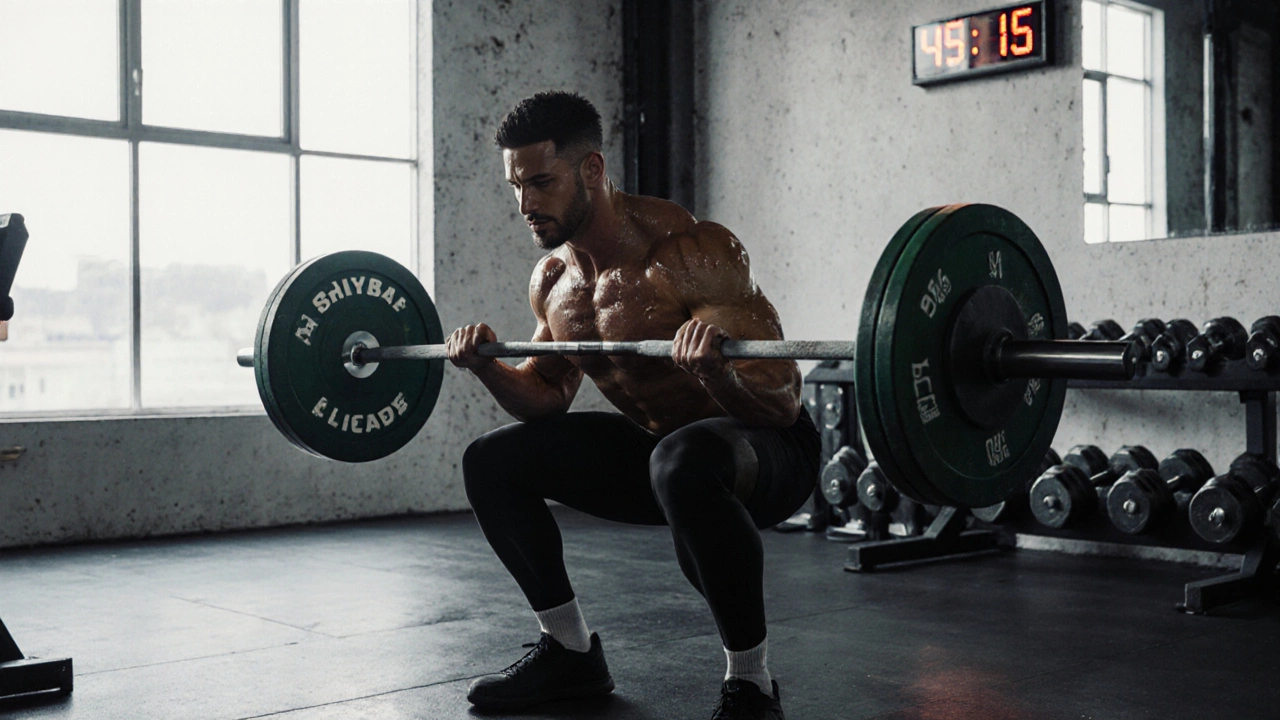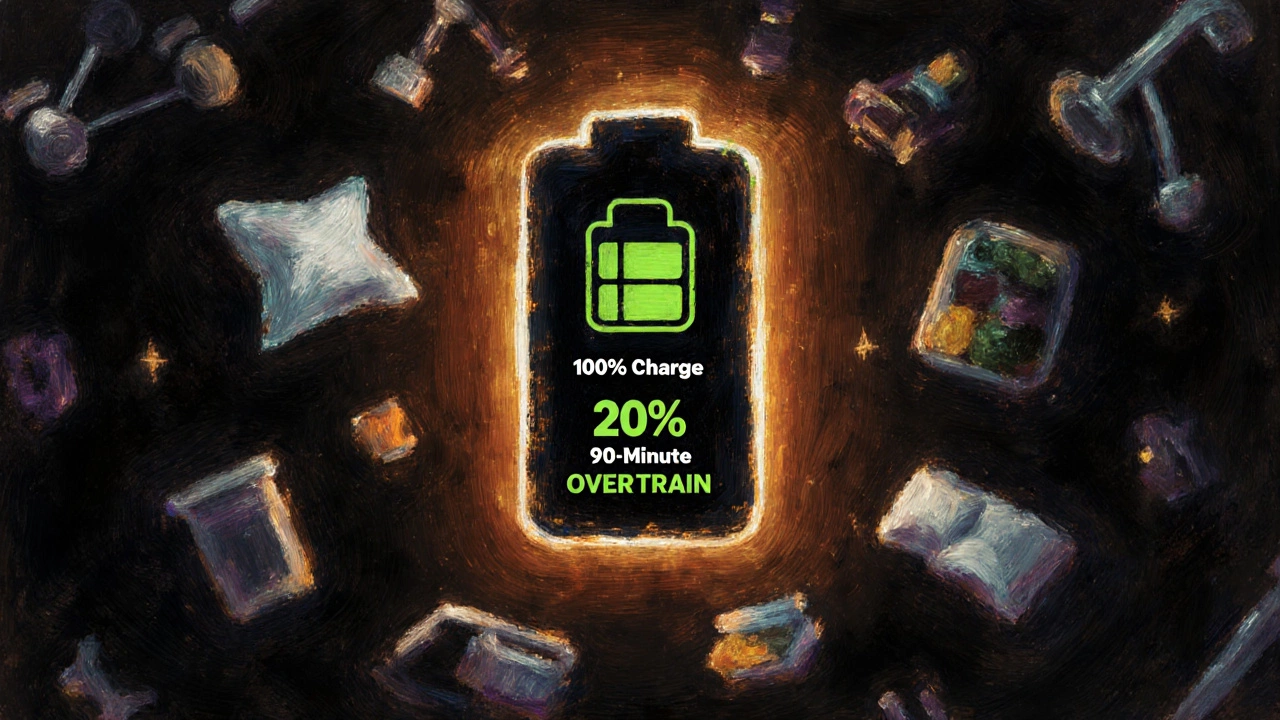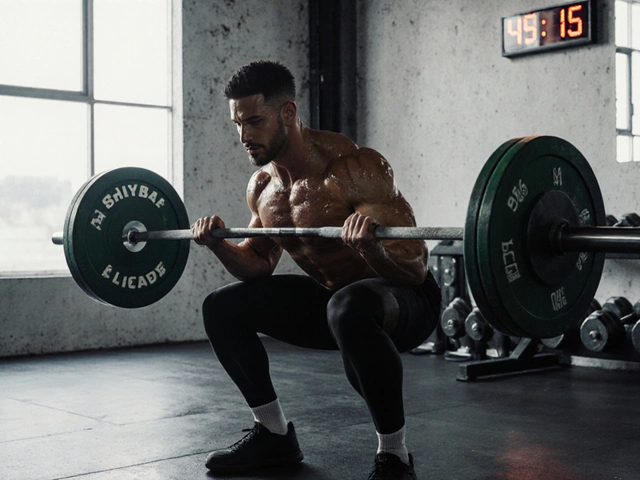How Long Should a Gym Session Be for Real Results?

Gym Session Duration Calculator
What's your primary fitness goal?
Build Strength
Focus on heavy compound lifts with 2-3 minutes rest between sets
Build Muscle (Hypertrophy)
Higher volume with 60-90 seconds rest between sets
Weight Loss or Endurance
Mix cardio with resistance training in shorter sessions
Stay Active
Simple movement to avoid sitting all day
Select your goal above to see recommendations
Your session length will be determined after you select your goal
Key Tips from the Article
- ⏰ Less is more: Workouts longer than 90 minutes increase overtraining risk and hormonal imbalance.
- 💪 Focus on intensity: Quality matters more than duration for results.
- 🔄 Recovery is part of training: Rest days and proper sleep are crucial for progress.
Most people walk into the gym with a plan: get in, get strong, get out. But then they stare at the clock, wonder if they’re doing enough, and end up staying too long-or leaving too soon. The question isn’t just how long should a gym session be? It’s: How long should it be to actually work?
There’s no one-size-fits-all answer
Some people swear by 90-minute monster sessions. Others hit the weights for 30 minutes and call it a day. Both can be right. The real answer depends on what you’re trying to build: strength, muscle, endurance, or just a habit that sticks.
Research from the American College of Sports Medicine shows that people who train 3-5 times a week for 30-60 minutes see measurable gains in strength and body composition. But here’s the catch: those results don’t come from length. They come from intensity, consistency, and recovery.
If you’re spending two hours at the gym every day and still not seeing progress, you’re probably not training smarter-you’re just training longer.
What your goal determines your session length
Your workout time should match your goal. Not your Instagram feed. Not your friend’s routine. Yours.
- Building strength: 45-60 minutes. Heavy compound lifts like squats, deadlifts, and bench presses need rest between sets. Three to five sets of 3-6 reps with 2-3 minutes rest? That’s 45 minutes right there. Add a few accessory movements, and you’re at 60. More than that? You’re just tired.
- Building muscle (hypertrophy): 60-75 minutes. You’re doing 3-4 sets of 8-12 reps with 60-90 seconds rest. That’s more volume, more time under tension. But push past 90 minutes and your testosterone drops, cortisol rises, and your body starts breaking down muscle instead of building it.
- Weight loss or endurance: 30-50 minutes. Cardio doesn’t need hours. A 20-minute HIIT session burns more fat than 45 minutes of slow treadmill walking. Pair that with 20 minutes of resistance work, and you’ve got a full fat-burning session in under an hour.
- Just staying active: 20-30 minutes. If your goal is to move daily and avoid sitting all day, you don’t need a full gym session. A quick circuit of bodyweight moves, a brisk walk on the treadmill, or 15 minutes on the rower gets the job done.
Why longer isn’t better
There’s a myth that more time = more gains. It’s not true. In fact, studies show that workouts over 90 minutes increase the risk of overtraining, joint strain, and even immune suppression.
A 2023 study in the Journal of Strength and Conditioning Research found that lifters who trained 60 minutes or less saw equal or better muscle growth than those training 90+ minutes-despite doing fewer total sets. Why? Because they recovered faster. They slept better. They showed up consistently.
Long sessions also lead to mental burnout. You start dreading the gym. You skip days. You lose momentum. That’s worse than never starting.
Think of your workout like a phone battery. You don’t charge it for 12 hours to make it last longer. You charge it just enough to get through the day. Same with your body.

How to structure a 45-minute gym session
Here’s a simple, proven template that works for most people:
- Warm-up (5 minutes): Dynamic stretches, light cardio-jump rope, rower, or brisk walk. Get your blood moving.
- Main lift (15-20 minutes): One heavy compound movement. Squat, deadlift, bench press, or pull-up. 3-5 sets. Keep rest periods tight (90 seconds max).
- Accessory work (10-15 minutes): Two to three isolation or supporting moves. Dumbbell rows, lunges, shoulder press, bicep curls. Keep reps in the 8-15 range.
- Cardio or core (5-10 minutes): 5 minutes on the bike or stair climber, or 3 core moves (plank, hanging leg raises, Russian twists).
Total? 45 minutes. No fluff. No scrolling. No chatting. Just focused work.
Signs you’re spending too much time in the gym
You’re not lazy. You’re just confused. Here are red flags that tell you your session is too long:
- You’re exhausted by the end and can’t function the next day.
- You’re skipping meals because you’re too tired to eat.
- You’re always sore, never strong.
- You check your phone every 5 minutes because you’re bored.
- You feel guilty if you leave before 90 minutes.
If any of these sound familiar, cut your time in half and increase your focus. Better to do 30 minutes with full attention than 90 minutes on autopilot.
What to do if you have more time
Some people have 2 hours between work and dinner. What do they do with it?
Don’t fill it with more lifting. Use the extra time for:
- Stretching or mobility work (foam rolling, yoga)
- Walking outside or doing light activity
- Meal prep or hydration
- Reviewing your progress in a journal
Recovery isn’t the opposite of training. It’s part of it. And recovery doesn’t happen on the bench.

Consistency beats duration every time
Here’s the truth: someone who trains 30 minutes, three times a week, for a year will outperform someone who trains 90 minutes once a week for the same time.
It’s not about how long you stay. It’s about how often you show up. How hard you push when you’re there. How well you sleep and eat after.
Most people fail because they think they need to do more. They don’t. They need to do better.
So next time you walk into the gym, ask yourself: What’s my goal today? Then set a timer. Stick to it. Leave when it’s done. Your body will thank you.
What about beginners?
If you’re new, start with 20-30 minutes. Focus on learning form, not lifting heavy. Do two full-body sessions a week. That’s it.
Don’t try to copy the guy doing 5 sets of 15 exercises. You’ll burn out. You’ll get hurt. You’ll quit.
Progress isn’t linear. But consistency is. A 25-minute workout done three times a week for six months will change your body more than a 90-minute session done once a month.
Is a 30-minute gym session enough to build muscle?
Yes, if you train with intensity. A 30-minute session focused on compound lifts (squats, deadlifts, push-ups, rows) with minimal rest can stimulate muscle growth. The key is volume and progression-not time spent. Most beginners and intermediates see results with 3-4 sets per muscle group per session, which fits perfectly in 30 minutes.
Can I work out for 2 hours every day?
You can, but you shouldn’t unless you’re a professional athlete or have a coach guiding recovery. For most people, training over 90 minutes daily leads to overtraining, higher injury risk, and hormonal imbalances. Your muscles grow when you rest-not when you’re sweating. Two hours a day is usually more about ego than results.
Should I do cardio and weights in the same session?
Yes, but order matters. Do strength training first. Your muscles are fresh, so you lift heavier and safer. Save cardio for the end-20 minutes max. If you do cardio first, you’ll drain your energy and compromise your lifting form. That’s how injuries happen.
How often should I go to the gym if I’m short on time?
Three times a week is the sweet spot for most people. Two full-body sessions and one focused on strength or cardio works better than five half-hearted sessions. Even two solid 30-minute workouts a week will keep you progressing if you’re consistent. Quality beats frequency every time.
What if I only have 15 minutes to work out?
Use it. Do a circuit: 5 push-ups, 10 squats, 15-second plank, 10 lunges. Repeat 3 rounds with no rest. That’s 15 minutes. It’s not glamorous, but it’ll raise your heart rate, activate major muscles, and keep you moving. Movement is medicine-even in small doses.
Final takeaway
The best gym session is the one you actually do. Not the one you plan. Not the one you see online. The one you show up for.
Forget the clock. Focus on the lift. Focus on the breath. Focus on showing up again tomorrow.
That’s how real change happens.



